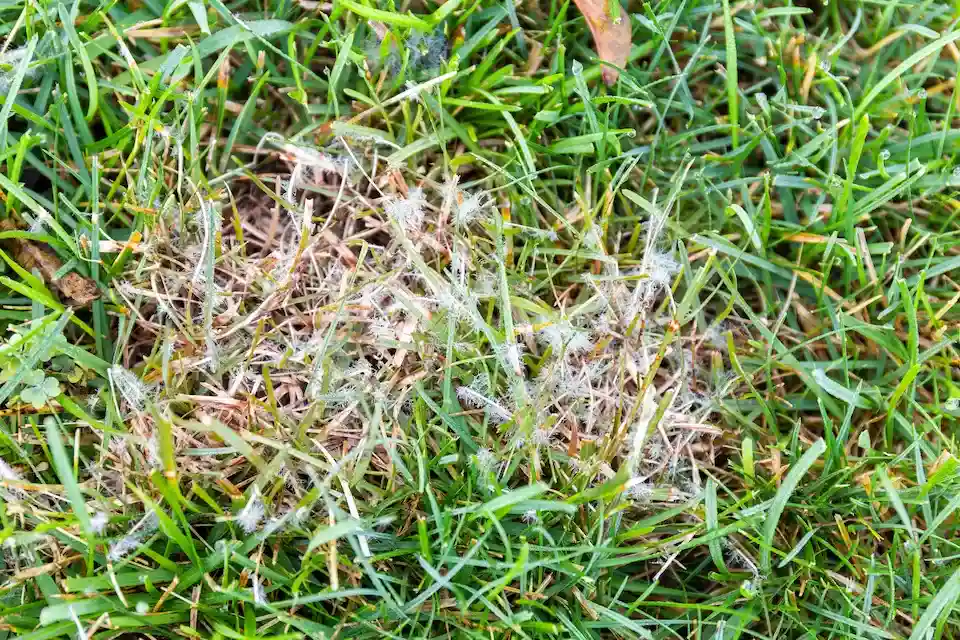
When you look out at your lawn is it green and plush? If you’re noticing a brown patch or two or areas of tan coloring, your lawn may have some Bermuda grass Dollar Spot fungus. While it may not be what you want to hear, the good news is that it’s not only treatable but also preventable.
The lawn fertilization team at FortSmith Landscaping is committed to not only taking care of your lawn but also giving you the information you need to have a healthy lawn. Here, we’re going to tell you everything you need to know about Dollar Spot fungus as well as the causes and what measures you can take to prevent and treat it.
What is Dollar Spot Lawn Disease?
Dollar Spot lawn disease is a common problem that impacts many different types of turf grasses.
Dollar Spot is a lawn fungus that gets its name from the light tan, circular patches that it makes on your lawn. At first, you’ll notice that each spot is only about the size of a silver dollar. You’ll start to notice a dollar spot infection as a silver fungus on your lawn.
As the disease spreads, the patches can run into one another to form large, irregular patches that are discolored and can range several feet in diameter. Dollar Spot disease attacks leaf blades, not the roots or soils. You’ll notice tan bands across the blade, often with reddish-brown margins either above or below each band.
How to Identify Dollar Spot Fungus In Bermuda Grass
Dollar Spot fungus on Bermuda grass is pretty easy to identify. It not only includes the spots we mentioned above but also, makes the grass blades look like straw. As you can imagine, this does nothing for your curb appeal or the overall look of your lawn.
Dollar Spot includes small, bleached round spots on the turfgrass ranging between 5–6 inches in home lawns. The disease also converts the color of the grass to a tan color that looks similar to straw, compromising its overall natural look and luster. You may find these dollar spots on a wide variety of turfs.
If your lawn is affected by Dollar Spot disease, the blades will be upright and will be pale or wide at first. They’ll then change color with a reddish-brown margin.
The tips of the leaves will also die, which can indicate dollar spot disease. You may not notice this sign if the turfgrass is closely cut. Instead, you’ll see the leaves turn white or tan on the tips. The grass will start to die in these spots as the disease spreads throughout the lawn. You may also notice short, fuzzy, mycelium forming on the turf.
What Causes Dollar Spot?
There are many different reasons why your lawn may have developed Dollar Spot.
Temperature
Dollar Spot disease development is more prevalent in warmer temperatures. For dollar spot patches to develop, the temperature needs to be at least warmer than 50 degrees Fahrenheit.
Weather Conditions
Soil conditions in your lawn can lead to dollar spot patches. Spring tends to be a popular time for dollar spot development as temperatures start to warm up.
Drought Conditions
Drought conditions can wreak havoc on your lawn. Lawns that have already been stressed due to drought conditions can become more susceptible to developing Dollar Spot or other lawn diseases.
Wet Leaves
Moist, wet leaves can become an open invitation for Dollar Spot to appear. It needs a certain level of wetness to spread and consistent leaf wetness can be just what it needs to thrive.
Lack of Nutrients
Lawns with lower potassium levels can be more prone to Dollar Spot fungus. Be sure that your lawn is getting the proper nutrients if you want to keep dollar spot away.
Excessive Thatch and Frequent Irrigation
When there is excess thatch and excessive irrigation, it can be hard for turfgrass to stay healthy. This combination of factors makes it difficult for lawns to absorb nutrients and makes them more prone to Dollar Spot and other diseases.
What Grass Types are More Prone to Dollar Spot?
Bermuda grass, Kentucky grass, and perennial ryegrass are all at higher risk of developing Dollar Spot compared to other types of cool-season grasses and warm-season turfgrasses.
How to Prevent Dollar Spot
No one wants to see Dollar Spot on their lawn. Follow these tips to help prevent it from forming:
- Keep leaves and other debris off your lawn. The fungus can grow during the winter and control your lawn once Spring arrives.
- Mow the grass regularly and don’t cut more than 1/3 of the grass blade. Cutting too much can weaken your lawn.
- Leave grass clippings behind when your grass is healthy. This will help to retain moisture and add nutrients to the soil. You don’t want to leave grass clippings behind if your lawn already has Dollar Spot disease. This will only lead to the problem getting worse.
- Get a sprinkler system to help water your grass effectively and evenly.
- Test your soil regularly to see what types of nutrients it may be missing. These soil test results can help to keep your soil healthy and your grass disease-free.
- See if your grass can benefit from fertilizer so that it can receive the nutrients it needs.
- Aerate compacted soil because if the soil is compacted, water, oxygen, and nutrients, won’t be able to get to the grass roots. Low air movement can be very damaging to the soil.
- When it comes to Dollar Spot management, be sure to remove existing weeds. Weeds work against you and compete for nutrients, space, light, and moisture. Taking them out gives your grass a better chance of surviving.
- Control grubs and other pests. If left untreated, they can weaken your turf by feeding on its root system.
- Look to apply a pre-emergent herbicide to prevent weeds from growing and damaging your lawn.
Treating Dollar Spot
Dollar Spot Disease Management with Chemicals
If your Bermuda lawn has a fungal disease such as dollar spot, your first move may be to stock up on chemicals, But, chemical control is not getting to the root of the problem. Treating and controlling Dollar Spot requires taking care of the environmental factors that resulted in the problem.
Fungicides can be a part of your treatment plan, but they shouldn’t be the only thing you do to control fungal growth. For effective Dollar Spot control and treatment, you want to choose the right type of fungicide. This is why it’s always a good idea to have professionals take care of your lawn and deal with these types of problems when they arise.
Proper Lawn Care
Proper lawn care is one of the most important things you can do to keep a healthy lawn. Removing excess leaf debris and making sure your lawn gets the right amount of water can all help.
When it comes to mowing your lawn, keeping it at the right height plays a big role in keeping it healthy and dollar-spot-free. You don’t want to mow the lawn too low because it can cause scalping. This weakens the grass and makes it more prone to Dollar Spot and other diseases. Be sure not to cut off more than one-third of the leaf blade during any mowing session.
Are You Looking to Treat Dollar Spot and Have a Healthy Lawn?
FortSmith Landscaping has a team of professionals who can help to keep your lawn healthy and disease-free. Our lawn care services are the best in the business and provide preventative care to keep your lawn plush and healthy. Call us today at (919) 228-8495 or reach out online to schedule an appointment!
